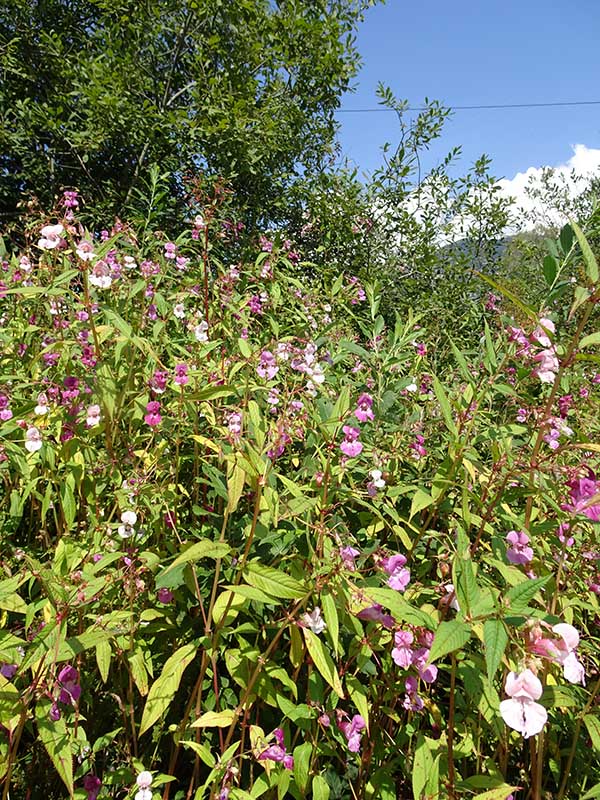Invasive neophytes are alien plant species that came to Europe with the direct or indirect help of humans and have successfully established themselves in this country. Some of these species, such as balsam, Japanese knotweed, Canadian or giant goldenrod, also spread unhindered in the Styrian Ennstal and form large dominant populations. Alien plant species can cause enormous economic, ecological and health damage.
The European Parliament Regulation 1143/2014 “On the prevention and management of the introduction and spread of invasive alien species” obliges the member states to implement the requirements at national level. This list includes all those invasive plant and animal species that have either not yet reached Europe (prevention) or are already causing problems in the member states, so that appropriate management must be carried out. The current list also includes balsam and the corresponding management measures are currently being developed.
The glandular balsam (Impatiens glandulifera) was introduced from the Himalayan region as an ornamental plant in the 19th century. In 1889 there was first evidence at Weidlingbach (Lower Austria). This annual, light-loving plant species shows considerable vigor and spreads enormously near wet meadows and bodies of water. Due to their small root mass and their death in autumn, the risk of erosion along bodies of water increases. Each plant can produce around 2,500 seeds, which are distributed via a spinning mechanism. The seeds remain viable for up to 7 years and are spread mainly via water (floatable seeds) but also via soil, garden waste and work tools. Due to the long germination of the seeds, long-term control measures are required.
Once exposed (e.g. as a privacy hedge, ornamental plant) or unintentionally landed on your own property via work equipment or excavated material, the Japanese knotweed (Fallopia japonica) can hardly be tamed. The transfer of contaminated earth material to landfills must therefore be urgently reconsidered, as new colonization with invasive species often occurs via this spread vector and high follow-up costs can be expected under certain circumstances. The roots of Japanese knotweed grow several meters deep and can cause major damage to buildings. The fast-growing, perennial perennials are extremely invasive and form mass populations, so that the autochthonous, site-adapted, slope-stabilizing vegetation is displaced. The death of above-ground plant parts in autumn increases the risk of erosion along bodies of water.
The Canadian goldenrod and the giant goldenrod (Solidago canadensis, Solidago gigantea) are still popular ornamental plants and, like the balsam, are also often seen by beekeepers as decorative plants for bees. These perennial species grow primarily along railway and road embankments. They reproduce via seeds (approx. 19,000/plant) and root runners. It spreads via wind, earth material, watercourses (root parts) and implements. The root runners form a dense network that makes combating them extremely difficult.
Active against invasive neophytes in the Styrian Ennstal - a success story from five years of management and care
In problem areas in the communities of Irdning-Donnersbachtal, Stainach-Pürgg and Wörschach, the non-native plant species have been removed with great care for the past five years, particularly along protected areas and on wetlands. Visible successes have already been achieved through regular mowing of the dominant stands, consistent uprooting before seeds begin to form and professional disposal, particularly of inflorescences with ovules. After consistent, expert work, the invasive species were greatly reduced in biotopes that were valuable in terms of nature conservation.
At the annual neophyte action days, which are organized by the HBLFA Raumberg-Gumpenstein and the mountain and nature rescue service, the participants learn about the problems, distribution patterns and control measures. “Clear the hot spots” is the motto, otherwise these robust plants will overgrow valuable habitats. Everyone can help with the measures to bring more plant species diversity back into the local cultural landscape.
Management to eliminate invasive plant species is also a focus of the international project “CAMARO-D – Transnational Cooperation for Water Conservation and Protection from Floods in the Danube Region”. Instructions for practitioners will be created together with the Styrian Mountain and Nature Rescue Service and the project partners and will be presented in spring 2019 as part of a practical seminar. Two students from HBLFA Raumberg-Gumpenstein are working intensively on the invasive neophytes in the district as part of their pre-scientific Matura work. They document hot spots, research properties and distribution tendencies and examine various control methods for their effectiveness.
In the ELER project “Measures to preserve biodiversity in Styrian protected areas and valuable habitats” by the State of Styria and the Steiermärkische Berg- und Naturwacht, practical and awareness-raising activities on the subject of invasive neophytes are being implemented.








